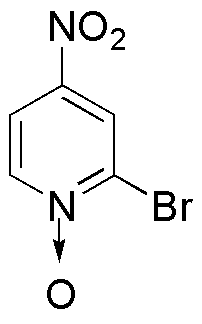2-Bromo-4-nitropyridine N-oxide is widely utilized in research focused on:
- Synthetic Chemistry: This compound serves as an important intermediate in the synthesis of various organic compounds, particularly in the development of pharmaceuticals and agrochemicals.
- Pharmaceutical Development: It is used in the creation of new drug candidates, especially those targeting bacterial infections, due to its unique chemical properties that enhance biological activity.
- Material Science: The compound is explored for its potential in developing new materials, such as polymers and coatings, that require specific electronic or optical properties.
- Analytical Chemistry: It acts as a reagent in analytical methods to detect and quantify other chemical species, providing reliable results in various laboratory settings.
- Environmental Chemistry: Researchers utilize this compound to study its behavior and degradation in the environment, contributing to the understanding of pollutant dynamics and remediation strategies.
General Information
Properties
Safety and Regulations
Applications
2-Bromo-4-nitropyridine N-oxide is widely utilized in research focused on:
- Synthetic Chemistry: This compound serves as an important intermediate in the synthesis of various organic compounds, particularly in the development of pharmaceuticals and agrochemicals.
- Pharmaceutical Development: It is used in the creation of new drug candidates, especially those targeting bacterial infections, due to its unique chemical properties that enhance biological activity.
- Material Science: The compound is explored for its potential in developing new materials, such as polymers and coatings, that require specific electronic or optical properties.
- Analytical Chemistry: It acts as a reagent in analytical methods to detect and quantify other chemical species, providing reliable results in various laboratory settings.
- Environmental Chemistry: Researchers utilize this compound to study its behavior and degradation in the environment, contributing to the understanding of pollutant dynamics and remediation strategies.
Documents
Safety Data Sheets (SDS)
The SDS provides comprehensive safety information on handling, storage, and disposal of the product.
Product Specification (PS)
The PS provides a comprehensive breakdown of the product’s properties, including chemical composition, physical state, purity, and storage requirements. It also details acceptable quality ranges and the product's intended applications.
Certificates of Analysis (COA)
Search for Certificates of Analysis (COA) by entering the products Lot Number. Lot and Batch Numbers can be found on a product’s label following the words ‘Lot’ or ‘Batch’.
Número de catálogo
Número de lote/lote
Certificates Of Origin (COO)
This COO confirms the country where the product was manufactured, and also details the materials and components used in it and whether it is derived from natural, synthetic, or other specific sources. This certificate may be required for customs, trade, and regulatory compliance.
Número de catálogo
Número de lote/lote
Safety Data Sheets (SDS)
The SDS provides comprehensive safety information on handling, storage, and disposal of the product.
DownloadProduct Specification (PS)
The PS provides a comprehensive breakdown of the product’s properties, including chemical composition, physical state, purity, and storage requirements. It also details acceptable quality ranges and the product's intended applications.
DownloadCertificates of Analysis (COA)
Search for Certificates of Analysis (COA) by entering the products Lot Number. Lot and Batch Numbers can be found on a product’s label following the words ‘Lot’ or ‘Batch’.
Número de catálogo
Número de lote/lote
Certificates Of Origin (COO)
This COO confirms the country where the product was manufactured, and also details the materials and components used in it and whether it is derived from natural, synthetic, or other specific sources. This certificate may be required for customs, trade, and regulatory compliance.


